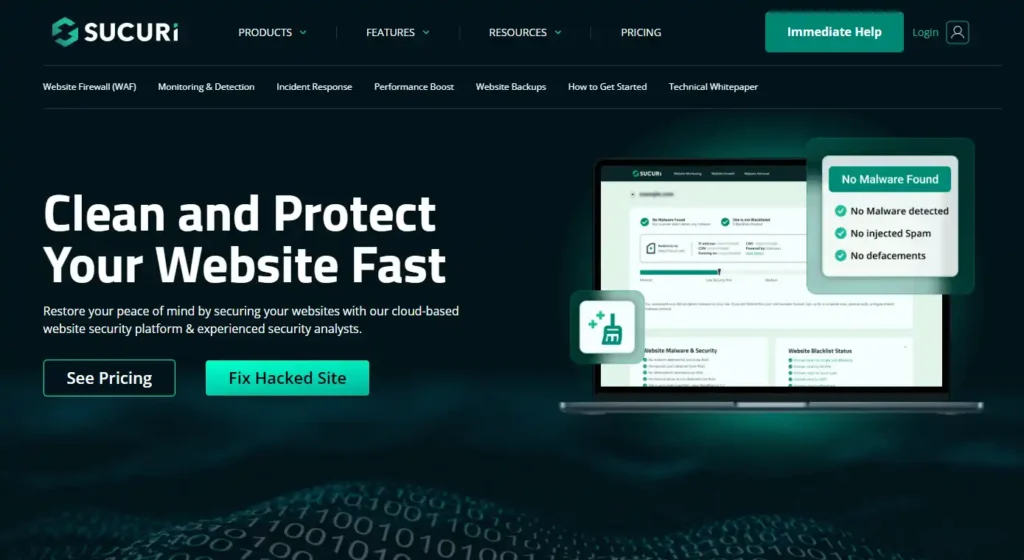
Top Security Plugins: Secure Your WordPress Site
Secure Your WordPress Site
In this post we take a look at the top security plugins for WordPress. As the internet grows, so does its vulnerabilities to cyber-attacks. WordPress, being the most popular content management system (CMS) on the internet, is a prime target for cybercriminals. In fact, on average, there are 44 attacks on WordPress sites every day. It is is vital therefore to secure your WordPress installation.
Website owners need to prioritize security to ensure their site remains safe and operational. Fortunately, there are many security plugins available that can help protect WordPress sites. In this article, we will introduce the top security plugins, their features, user ratings, and pricing. By doing so, we aim to help website owners choose the right security plugin for their needs and budget.
When it comes to securing WordPress sites, there are many factors to consider. Apart from selecting the right security plugin, website owners must also ensure GDPR compliance, avoid hacked plugins, and implement strategies for creating secure WordPress contact forms and anti-spam protection.
Therefore, this article will not only provide a comparison of the top security plugins but also discuss additional security considerations to keep in mind. By doing so, we hope to provide website owners with a comprehensive guide to securing their WordPress site and protecting it from cyber threats.
With innovation being the driving force of the internet, it is crucial to stay up-to-date with the latest security measures to ensure the longevity and safety of your website.

Key Takeaways
- WordPress’ security is recommended for all sites, as the average website is attacked 44 times per day, and breaches can lead to data theft and malware distribution.
- Choosing a security plugin should be based on the level of protection needed and budget, with two-factor authentication and password enforcement being important features to consider.
- Redundant plugins can cause problems, and hacked plugins should be avoided.
- Sucuri is one of the best WordPress security plugins, offering website scanning, DNS-level firewalls, and a cloud-based server and CDN network. The pro version is worth the investment for peace of mind.
- Wordfence is another great security plugin, offering a firewall, malware scanner, Brute Force Protection and other great features. These and more are available even in the free version.
Security Plugin Comparison
The comparison of features, user ratings, and pricing was used to narrow down a list of the best WordPress security plugins. These include Sucuri, iThemes Security Pro, Jetpack, WPScan, Wordfence, BulletProof Security, All In One WP Security Firewall, and Google Authenticator. In this post we will focus on what I regard as the top two: Wordfence and Sucuri.
Two-factor authentication and password enforcement were identified as essential features to consider, while redundant plugins may potentially cause compatibility issues and affect user experience.
When selecting a WordPress security plugin, it is crucial to weigh the level of protection needed against the budget available. It is also recommended to avoid hacked plugins and choose a plugin that is GDPR-compliant.
Premium versions of some of these plugins, such as Sucuri Security, may be worth the investment for peace of mind, especially for larger sites with user information that may require additional protection such as 2FA.
Sucuri Features and Pricing
Sucuri offers an extensive range of security features, making it one of the most effective WordPress security plugins available in the market. Some of the features that make Sucuri stand out include website scanning, DNS-level firewalls, and a cloud-based server and CDN network.
These features together make Sucuri a top choice for those seeking comprehensive WordPress protection. In addition to these features, Sucuri also offers multiple layers of protection against malware, brute-force attacks, spam, and other common threats to WordPress sites.

Basic Platform:
Perfect for bloggers and small site owners requiring occasional clean-ups with ongoing security scans. Costs $199.99/yr.
- Covers 1 site
- Unlimited malware and hack removals by the support team
- Malware Service Level Agreement is 30 hours
- Post-clean-up report – basic
- Frequency of advanced security scans – every 12 hours
- Website Application Firewall (WAF) – included.
- Blocklist Monitoring & Removal – included.
- SSL Support & Monitoring – included.
- Stop Hacks (Virtual Patching/ Hardening) – included.
- Firewall Protection – HTTPS & PCI-compliant – included.
- Advanced DDoS Mitigation – included.
- CDN Speed Enhancement – included.
- High Availability/Load Balancing – included.
Pro Platform:
Ideal for SMBs who want to minimize disruptions with advanced support for quick SSL certificate transfers. Costs $299.99/yr.
- Covers 1 site
- Unlimited malware and hack removals by the support team
- Malware Service Level Agreement is 12 hours
- Post-clean-up report – basic
- Frequency of advanced security scans – every 6 hours
- Website Application Firewall (WAF) – included.
- Blocklist Monitoring & Removal – included.
- SSL Support & Monitoring – Advanced.
- Stop Hacks (Virtual Patching/ Hardening) – included.
- Firewall Protection – HTTPS & PCI-compliant – included.
- Advanced DDoS Mitigation – included.
- CDN Speed Enhancement – included.
- High Availability/Load Balancing – included.
Business Platform:
Fastest response time for site clean-ups with frequent scans to avoid vulnerabilities. Costs $499.99/yr.
- Covers 1 site
- Unlimited malware and hack removals by the support team
- Malware Service Level Agreement is 6 hours
- Post-clean-up report – basic
- Frequency of advanced security scans – every 30 minutes
- Website Application Firewall (WAF) – included.
- Blocklist Monitoring & Removal – included.
- SSL Support & Monitoring – Advanced.
- Stop Hacks (Virtual Patching/ Hardening) – included.
- Firewall Protection – HTTPS & PCI-compliant – included.
- Advanced DDoS Mitigation – included.
- CDN Speed Enhancement – included.
- High Availability/Load Balancing – included.
Summary:
Sucuri offers comprehensive security features and is available not just for WordPress sites but also Joomla, Magneto, Drupal and phpBB. They claim 99% Support Ticket Satisfaction and clean over 700 hacked sites every day!
Wordfence Features and Pricing
Wordfence is my personal preferred choice (I am not sponsored for this – just my personal preference). Also, the free version of Wordfence will be perfectly adequate for most small sites (bloggers, landing pages etc). If you run an online store, then I recommend a paid version for that extra peace of mind.
Wordfence has a global team of WordPress security analysts, threat researchers, software engineers, and support staff. They focus exclusively on securing WordPress websites, and on WordPress security research. They provide 24-hour service, 365 days a year for mission-critical websites, with a 1-hour response time via Wordfence Response.
Note: Each installation of Wordfence (except for the free version) requires an individual licence. WordPress Multisite, however, only requires one licence as it is still a single installation of WordPress. See here for more details.
Wordfence Free:
Join over 4 million secure WordPress site owners using Wordfence Free. Block attacks with the basic tools you need to keep your site safe. 30-day delay on firewall rules and malware signatures. Entry-Level Sites that Need Basic WordPress Security. Costs $0
- The Wordfence Firewall – Rules delayed 30 days.
- The Wordfence Malware Scanner – Signatures delayed 30 days.
- Customer Support Level – Volunteer forums.
- Scheduled Security Scans – Every 3 Days.
- Plugin/Theme Vulnerability Monitoring – included.
- File Change Detection – included.
- Intrusion Alerts – included.
- Rate Limiting – included.
- Brute Force Protection – included.
- Login Security – 2FA & reCAPTCHA – included.
Wordfence Premium:
Self-Administered Websites that Need the Best Protection Against Existing and Emerging Threats. Costs $119/yr.
- The Wordfence Firewall – Real-time rules.
- The Wordfence Malware Scanner – Real-time signatures.
- Real-Time IP Blocklist – included.
- Country Blocking – included.
- Customer Support Level – Ticket based.
- Scheduled Security Scans – Unlimited.
- Plugin/Theme Vulnerability Monitoring – included.
- File Change Detection – included.
- Intrusion Alerts – included.
- Rate Limiting – included.
- Brute Force Protection – included.
- Login Security – 2FA & reCAPTCHA – included.
Wordfence Care:
Busy Business Owners Who Need Hands-on Support From a Dedicated Security Analyst. Costs $490/yr.
- The Wordfence Firewall – Real-time rules.
- The Wordfence Malware Scanner – Real-time signatures.
- Real-Time IP Blocklist – included.
- Country Blocking – included.
- Customer Support Level – Priority ticket based.
- Scheduled Security Scans – Unlimited.
- Security Audit & Recommendations – once a year.
- Plugin/Theme Vulnerability Monitoring – included.
- File Change Detection – included.
- Intrusion Alerts – included.
- Rate Limiting – included.
- Brute Force Protection – included.
- Login Security – 2FA & reCAPTCHA – included.
Wordfence Response:
Mission-Critical Sites that Require 24/7/365 Incident Response with a 1-Hour Response Time. Costs $950/yr.
- The Wordfence Firewall – Real-time rules.
- The Wordfence Malware Scanner – Real-time signatures.
- Real-Time IP Blocklist – included.
- Country Blocking – included.
- Customer Support Level – 1-hour response time.
- Scheduled Security Scans – Unlimited.
- Security Audit & Recommendations – Once yearly + optional second audit.
- Plugin/Theme Vulnerability Monitoring – included.
- File Change Detection – included.
- Intrusion Alerts – included.
- Rate Limiting – included.
- Brute Force Protection – included.
- Login Security – 2FA & reCAPTCHA – included.
- 24/7/365 Incident Response – included.
Summary:
Wordfence is for WordPress sites only. Its advantage over Sucuri is that it has a free version, which will be perfect for many sites. Personally, I have run the free version of Wordfence on numerous sites over many years. In every case, I never got hacked once. However, if you have a site that is an e-commerce site or you store confidential information of your customers in a database, I would recommend you use a paid-for version.




